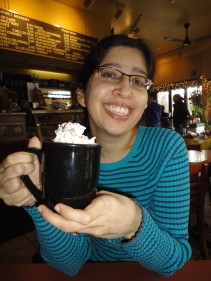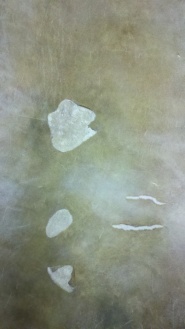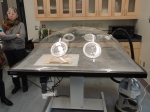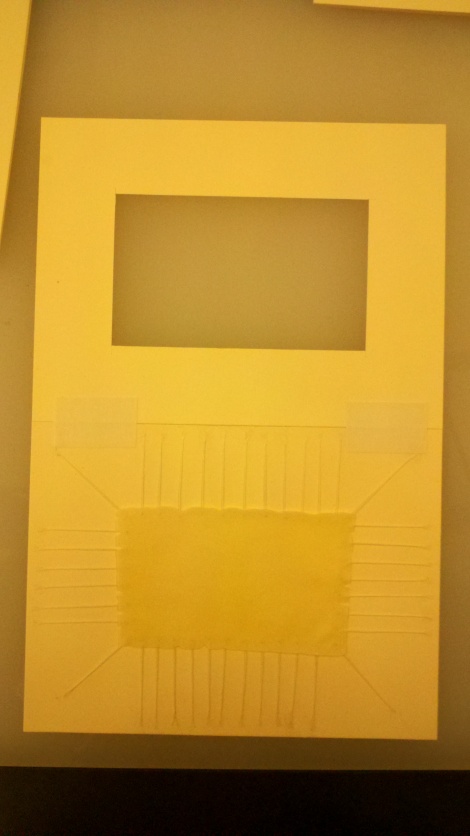Towards the end of January, my classmate Eve Mayberger and I, along with Emily Lynch (Class of 2014), attended a workshop on parchment manufacture and repair hosted by the Buffalo State College Art Conservation Department. The workshop taught by the amazing Abigail Quandt, Senior Conservator of Rare Books and Manuscripts at the Walters Art Museum in Baltimore, MD, who most recently worked on the Archimedes Palimpsest.
Eve and I flew into Buffalo a day before the workshop started, arriving in the city even before our respective hosts, second-year Buffalo students Halaina Demba and Graham Patten. Per Graham’s advice, we spent our extra time at lovely local spot, Café Aroma, where, I can attest, they make truly delectable hot chocolate.
The workshop began bright and early the next day, when we got to see the art conservation department’s newly refurbished facilities. As you can see from our pictures, their space is truly lovely! Each day was divided into a lecture portion in the morning and a hands-on component in the afternoon, with breaks for coffee and lunch built into the day. These breaks were honestly as interesting as the rest of the day. Because the workshop was attended by paper and book conservation students and faculty from the Buffalo, Delaware/Winterthur, and NYU programs, the breaks gave us all a chance to get to know each other.
Abigail Quandt started off the first day with a lecture on parchment production and use throughout history. This was supplemented by a hands-on workshop in the afternoon, where we learned ways in which to identify the parts of an animal as seen on the parchment. For example, the skin around the head and rump is tougher than the skin in other areas, and the follicle pattern also varies its position on the animal’s body. We also learned to identify the animal that a skin came from based on follicle patterns. I suspect much of this was repetitive for Eve, but I was fascinated!
- Abigail Quandt clipping and pinning parchment as Eve and Judy Walsh watch
- Abigail Quandt clipping and pinning parchment
- Abigail Quandt doing local humidification of a particularly stubborn crease
There were definitely moments within the workshop that I think were difficult for some of our stomachs, such as the display of parchment made from fetal or still-born animals; those skins, I have to admit, wrenched my heart a little. It is easy to overlook, but some of the objects and materials that we encounter in conservation are indeed tied to living things (as illustrated in Annika’s drawing of rabbit skin glue!)
Towards the end of the day, we were each handed a historic piece of parchment out of Ms. Quandt’s own collection and given the task of identifying the skin as best as possible. Considering the little experience we had, we all did fairly well, if I do say so myself! It was a great test of the knowledge we had gained theretofore.
The second day began with a series of lectures on parchment-deterioration mechanisms, as well as methods for cleaning, consolidation, humidification, and flattening. We were able to see the deterioration mechanisms in action that afternoon, when we were each allotted half a skin of sheepskin parchment and told to “distress” a section of it. I got somewhat carried away in distressing mine, as can be seen – I crumpled it, steamed it, heated a section through direct contact with a hotplate, wet a section under the faucet, and—for a final touch—stepped on it! I then attempted dry-cleaning the parchment, with mixed results. Unsurprisingly, it is difficult to effectively dry-clean something that is severely crumpled. However, after humidifying the parchment overnight and flattening it by first stretching out using clips and pins and then drying it under weight, the bulk of the damage was remedied to some extent. The only section that refused to flatten was the edge that had been heated in direct contact with the hotplate, where the parchment had gelatinized.
- The humidification chamber
- Parchment in the humidifcation chamber.
- Local humidification on the suction table
- This skin was stretched using wooden dowels
- Sewing a cut in my parchment with strips of parchment
- The set-up for clipping and pinning parchment
- Eve clipping and pinning her parchment
- AQ’s clipped and pinned parchment
- Eve with her distressed parchment
- As you can see, I really distressed my parchment!
This set the pattern for the last two days of the workshop. In the mornings, we attended lectures on repair methods and adhesives; in the afternoons, we tried out the methods ourselves. We attempted in-fills with paper as well as parchment, using a variety of adhesives from gelatin and isinglass. We tried using solvent-set tissue and goldbeater’s skin to mend tears. And we learned about mounting and displaying methods, including those used for the Archimedes Palimpsest.
The workshop was tremendously exciting, but what really made the trip wonderful was the interaction with the students from the other schools. The Buffalo State students and faculty were gracious and welcoming, and very helpful to three NYU students who arrived in Buffalo just in time for the cold front (accompanied by steady snow and frigid winds!)
- We really liked this idea of arranging common solvents
- This great poster was in the paper lab
- The paper lab even has these wonderful ergonomic chairs!
- A sign outside the Paper Conservation Lab at Buffalo State
The week wrapped up with a dinner at the house of Judy Walsh, professor and paper conservator at Buffalo State College. It was a fitting end to a wonderful week—spending time outside of class with the people I hope and expect will be my future colleagues.
~ Saira























Pingback: Two New Posts Up! | Cover to Cover·